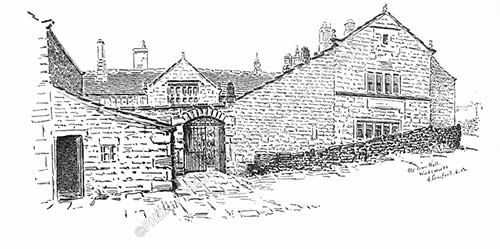Local History Society Report
Who put the hall in Old Town Hall?
Speaker: David Cant
Saturday, 16 October 2021
It was an immense pleasure to be back with an ‘in real life’ talk at Hebden Bridge Local History Society and to listen to a demonstration of the multitude of skills involved in the surveying of vernacular buildings and constructing a story about their past. David Cant has long experience working with the vernacular buildings of the Calder Valley, and his focus on Old Town Hall on the hills above Hebden Bridge exemplified the riddles and puzzles that face someone trying to make sense of an old building.

Documentry sources
The term ‘hall’ is used to apply to many spaces in buildings, from the humble entrance to a modern semi to the great hall of a medieval castle. In this case it is the name of the building itself, identified as such in a will of 1713. An essential part of tracing the history of a house is to make use of a variety of documentary sources. Alongside wills, maps are invaluable. In the case of Old Town there is a detailed Myers’ map from the 1830s which shows the hall, and a Christopher Saxton map from 1602 drawn to help with a dispute about pasture rights at Old Town. The first 6” OS map from the middle of the 19th century and the 25” OS map from 1964 chart some of the changes in the building known as Old Town Hall. Additionally there are good aerial photos and modern satellite images, which can clarify the layout in a way that is sometimes difficult on the ground.
Calder Valley houses built in the 17th century typically have a large central hall, known as the housebody, so part of the inquiry into Old Town Hall would involve identifying this room. Rather surprisingly, the Hall as it now stands seems to lack an easily identifiable hall.
Virtual tour of the outside of the building
David took the audience on a virtual tour of the outside of the building, noting significant architectural features on each elevation that could point to its history and the changes it had undergone. One gable, for example, showed a mix of features, with blocked up openings and new windows, changes made to accommodate new uses of the building over the centuries. Different architectural features contributed to the jigsaw of clues: the chamfered mullions and transoms typified windows of the 17th century as compared to the flat mullions of the later 18th and 19th centuries; the hood mouldings over the windows had both a practical and decorative function. An elegant archway into a courtyard, the finials on the roof and chimney stacks set at an angle suggested a prestigious building. The types of stonework used on the different gable ends suggested similar or different periods of building.
Inside there were more puzzles, with no large room at the centre which could have been the hall. Fireplaces raised more questions than answers: one that was undoubtedly 17th century but not particularly big; another with elegant surround was installed over a doorway; a large arched fireplace bizarrely contained mullion windows and the staircase of a later cottage conversion; and what looked like a blocked-in fireplace hung on an outside wall. Another key feature for the surveyor of vernacular buildings is the roof timbers. In the case of Old Town Hall the structures of different dimensions and strengths in different wings pointed to different periods of construction.
More documentary evidence
In order to turn the mix of puzzles and theories into a more coherent story, the existence of documentary evidence in the form of censuses, deeds, the rolls of the Manor Court, parish records, planning records, rates, wills and inventories can all be trawled for evidence to shed light on the history of a building.
In the case of Old Town Hall, David was able to weave together the documentary evidence of specific events and the architectural evidence of surveys to suggest reasons for some of the changes. He felt there was enough evidence to suggest a 16th century timber framed house which had been either demolished or encased in stone, as was common in the 17th century. Additions to the house which suggested a more prestigious style coincided with changes of ownership, and particularly owners who became occupiers. At the point when the textile manufacturing owners moved out, the building became an early textile factory, entailing more alterations, and eventually the conversion of one wing of the building to a row of cottages.
It was a fascinating and satisfying process of analysis and puzzle-solving that David emphasised involved a lot of team work, from the group of enthusiasts from the Yorkshire Vernacular Buildings Study Group, the co-operation of owners, and the expertise of archive staff.
Future talks
The next lecture, at Hebden Bridge Methodist Church on Wednesday 13th October at 7.30, will also feature a hall, when David Glover gives us a brief history of Shibden Hall.
Details of the talks programme, publications and of archive opening times are available on this website and you can also follow the Facebook page.
With thanks to Sheila Graham for this report
See also

